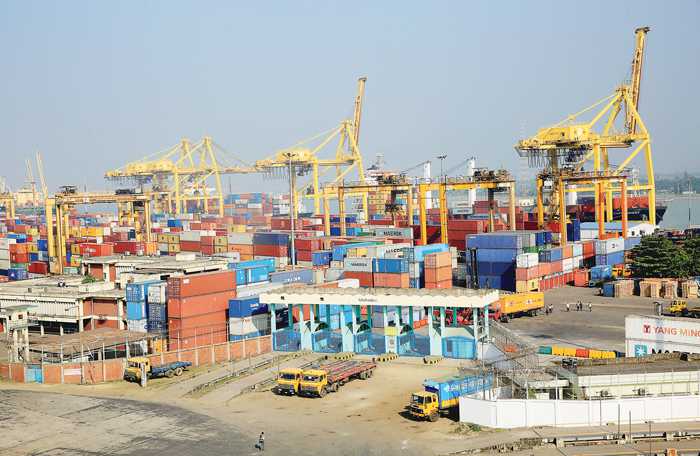Robust export, scandal-ridden banking sector mark 2018

In the first five months of the current fiscal year (FY2018-19), Bangladesh's export earnings increased by 17.24% to $17.07 billion, from $14.56 billion in the previous fiscal year
Riding on the waves of robust export earnings growth and healthy remittance inflows, the macroeconomic performance of Bangladesh showed significant stability in 2018.
Improvements in workplace safety in the apparel sector played an important role in expanding export earnings by a significant margin in the second half of the year.
Speaking to the Dhaka Tribune, business persons and economists credited the government's long-term business-friendly policies and success in ensuring political stability, as the main reasons behind the country's economic growth.
Robust growth in export earnings
Exporters Association of Bangladesh (EAB) President Abdus Salam Murshedy said: “Since the government has successfully upheld peace in the country, conducting business has not encountered many hurdles. The steady economic growth that Bangladesh is experiencing is mainly due to policy support from the government.”
Salam, also a former president of Bangladesh Garment Manufacturers and Exporters Association (BGMEA), further said that increased production capacity in the apparel sector also played a key role in boosting exports.
In the first five months of the current fiscal year (FY2018-19), Bangladesh's export earnings increased by 17.24% to $17.07 billion, from $14.56 billion in the previous fiscal year. The ready-made garments (RMG) sector saw an 18.59% rise to $14.18 billion from $11.96 in the previous fiscal year.
Economists and trade analysts suggest that Bangladesh's macroeconomic performance was also bolstered by an increase in agricultural production, the central bank's firm control over inflation, and an increase in remittance inflows.
Speaking about economic growth, Centre for Policy Dialogue (CPD) Research Director Khondaker Golam Moazzem explained: “In 2018, Bangladesh’s macroeconomy was stable as it registered a 7.86% GDP [gross domestic product] growth in FY2017-18, low inflation, adequate foreign exchange reserves, and sound remittance inflows, mainly due to government investment in infrastructural development and export growth.”
As of December 2018, Bangladesh's foreign exchange reserves stood at $32 billion, while remittance inflow reached $6.29 billion in the July-November period of FY2018-19.
Although export performance was poor in the beginning of 2018, it rose sharply in the second half of the year. "Global buyers have changed their sourcing destination to Bangladesh, which pushed up Bangladesh's export earnings," said Moazzem.
Sino-US trade also brought more export orders to Bangladesh, he added.
“The overall performance of Bangladesh's economy was mixed in the outgoing year, but there was a noteworthy and positive change in export growth,” World Bank (Bangladesh) Lead Economist Zahid Hussain told the Dhaka Tribune.
In the July-November period, export earnings showed a balanced growth with improved earnings in the non-RMG sector. It is a good indication that the non-RMG sector is doing better, said Zahid.
In the July-November period of FY2018-19, non-RMG sector export earnings rose by over 11% to $2.89 billion, from $2.6 billion for the same period in FY2017-18.
Notably, in FY2017-18, non-RMG exports saw a 7.47% fall to $6.05 billion from $6.50 billion in FY2016-17.
A weakening banking sector
According to Bangladesh Bank data, as of September 2018, total NPLs of the country’s banking sector stood at Tk99,370.92 crore, the highest ever in the history of Bangladesh.
“As of the end of 2018, NPLs in the country’s banking sector stood at around Tk100,000 crore, the highest Bangladesh has ever faced. This is because of a lack of good governance in the sector,” said World Bank Lead Economist (Bangladesh) Zahid.
He recommended reforming the entire sector in order to increase cash flows into the market and to bring discipline to the sector.
Non-participatory private sector
"Private sector investment still remains stagnant, which is needed for employment generation. It means, Bangladesh failed to capitalize on the economic growth in attracting investment and creating jobs," Zahid explained.
Echoing his concerns, CPD Research Director Moazzem said: "Private sector investment to GDP ratio is hovering around only 23%.
"Moreover, private sector investments made till now have not been inclusive as most of the investment came from big corporations and business groups – which has created a 'missing middle' in the economy," Moazzem explained. "Thankfully though, the government is trying to promote the SME sector."
He further observed that capital machinery imports also declined in 2018, indicating that new investment is decreasing.
Other challenges
There are also concerns regarding revenue collection, as it always falls short of the target.
As of November 2018, revenue collection stood at Tk77,935.82 crore, against a target of Tk101,704 crore. For FY2018-19, the government has set a revenue collection target of Tk296,201 crore.
Furthermore, the stock market, an important source of funds for business expansion, went through a negative trend in the index, market capitalization, and foreign investment.
As of December 27, 2018, DSEX, the key index of the Dhaka Stock Exchange, ended at 5,386 points, down by 13.75% or 859 points, from 6,243 points at the end of 2017.
While total transaction figures stood at Tk13,359 crore this year—which was 38.43% less than last year—market capitalization fell by 8.42% to Tk35,599 crore, and the average daily turnover throughout 2018 was Tk552.03 crore.
However, fund collections through Initial Public Offerings (IPO) has increased. In 2018, a total 13 companies raised Tk546 crore through IPOs, which was Tk219.25 crore in 2017.
Source: https://www.dhakatribune.com
Tags :
Previous Story
- As international factory safety group ordered to leave...
- Study cites Bangladesh progress amid political uncertainty
- The international project to fix Bangladesh’s garment industry...
- Until Western Brands Take a Stand, the Lives...
- Bangladesh to eject safety inspectors brought in after...
- Bangladesh clothing factories face squeeze if safety push...
- Closer to our shores
- Sustainable pricing is crucial for our apparel industry